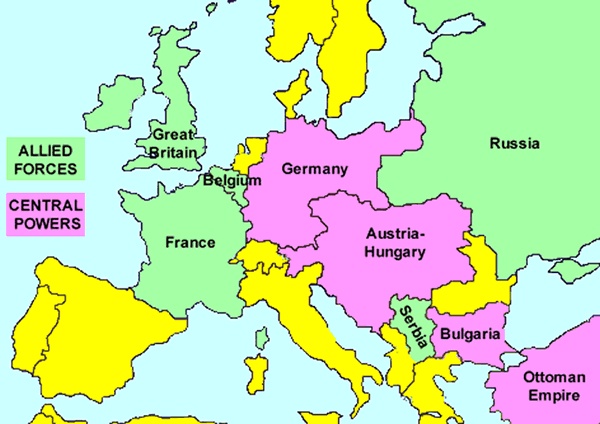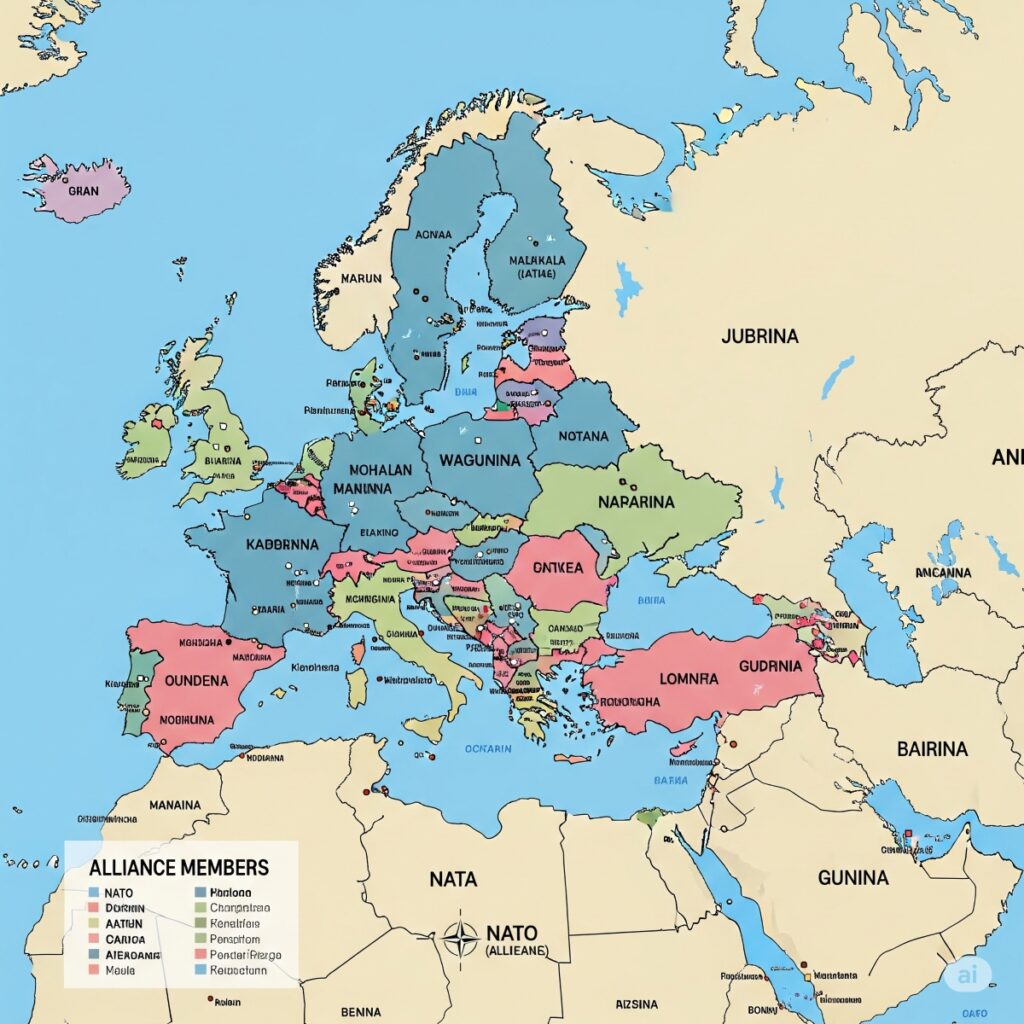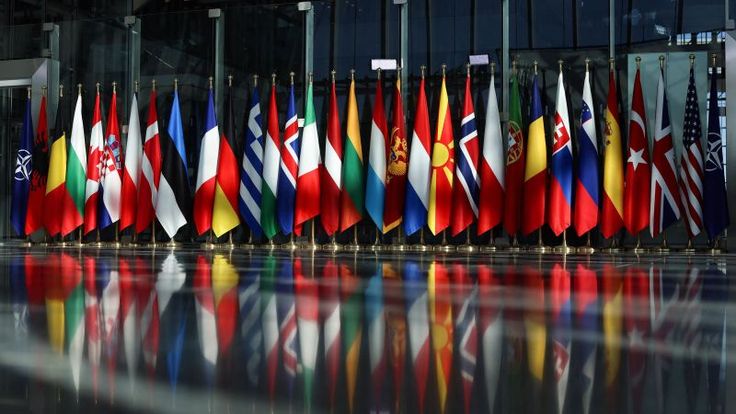If you’ve ever been pulled into a fight because of your friend, then you know how this story goes. What started as a mere argument could escalate into something much bigger, and before you know it, you’re caught up in a conflict that initially had nothing to do with you, all in the name of friendship.
“If you’ve ever been pulled into a fight because of your friend, then you know how this story goes.”
Now, imagine this friendship being between countries in Europe and beyond.
This is part of what led to the First World War: arguments between “friends” and the picking of sides. Europe was divided due to the “alliance system.” The Triple Entente consisted of France, Britain, and Russia, while Germany, Austria-Hungary, and Italy formed the Triple Alliance.
This alliance system not only divided Europe, but its dynamics also shaped how countries entered World War I. While some of the alliances were dissolved after the war, their dynamic is very much alive today. In 2025, modern alliances have shaped the conflicts in Western Europe and the Middle East, echoing for those of us who remember, just how close we are to another world war.
If you have no idea about what I’m talking about, don’t fret! In this post. I’ll break down how a small argument between friends led to the First World War and why it could happen again.
World War I: A Historical Drama in Three Acts
Your history teacher in school most likely told you that World War I started because of the assassination of Archduke Franz Ferdinand of Austria-Hungary by a Serbian nationalist on June 28, 1914. While it was the needle that broke the camel’s back, the situation had been building up for a while. I’ve broken down the drama that led to the first global conflict into three acts.

Act 1: The Formation of the Alliance System
At the start of the 20th century, European countries had chosen their friends. Picture them as two friend groups who have sworn to have each other’s backs, or as Gen Z would say, “cap no cap.” This led to the formation of two great alliances, namely:
- The Triple Alliance, a pact between Germany, Austria-Hungary, and Italy. These three central European countries were united by their desire to protect their countries from their neighbors.
- The Triple Entente was formed as a response to the Triple Alliance by France, Britain, and Russia. These three came together due to Germany’s growing power, and to ensure they wouldn’t fight the Germans alone. Talk about the enemy of my enemy being my friend.
Once the friendships were formed, they were bound by military agreements that a fight with one member country meant a battle with them all. You can see where this is going.
Act 2: The Incident That Lit the Fuse
With the countries allied with their friends, things on the surface were going well. So in June 1914, Archduke Franz Ferdinand, heir to the Austro-Hungarian Empire, decided to parade the streets in an open-top car. While happily greeting his people, he was shot by a 19-year-old Serbian nationalist identified as Gavrilo Princip.
This incident lit the fuse and started the fire that burned across Europe. The Austro-Hungarian Empire was determined to make the Serbians pay, and with the support of its ally, Germany, it declared war on Serbia on July 28, 1914.
Serbia knew it did not have what it took to face a German-backed Austria-Hungary in a direct conflict. So, it turned to its friend, Russia. Then, every friend of these countries got pulled into the conflict.
At this point, the question was not who would support their friend, but how far they were willing to go for them. And from what we know of the First World War, these friends went to great lengths for each other over the course of four years. But how did everyone get pulled into the war?
“At this point, the question was not who would support their friend, but how far they were willing to go for them.”
Act 3: The Domino Effect That Pulled Everyone In
The events after the assassination of the Archduke played out like this:
- Austria-Hungary sent a list of demands to Serbia, which Serbia did not comply with, leading to the declaration of war on July 28, 1914.
- Once war was declared, Russia, the self-assigned protector of Slavic people, started mobilizing its army to defend Serbia.
- Germany saw Russia’s army mobilization as a direct threat, and on August 1, it declared war on Russia. But Germany did not stop there.
- Two days later, Germany declared war on France on the sole condition that France is Russia’s friend. Germany then began marching through Belgium to reach France. So far, Belgium has stayed neutral, choosing not to pick a side; only if wishes were horses.
- Since wishes were not horses, Belgium was drawn into the conflict by Germany’s actions, which also triggered Great Britain, a friend of France and Russia, and one that had promised to defend Belgium’s neutrality. So, on August 4, 1914, Britain declared war on Germany, and the rest, as they say, is history. But we’re not done yet.
The local conflict between Austria-Hungary and Serbia brought in their friends who were never a part of it, leading to a war that affected international relations and cost millions of lives. Years have passed since World War I, but alliances remain in place and continue to shape geopolitical conflicts, taking us to the friendships of 2025.
“The local conflict between Austria-Hungary and Serbia brought in their friends who were never a part of it.”
In 2025, It’s the Same Script But Different Actors
In 2025, the same script that led to World War I is being acted out by different actors. The friend group today ranges from NATO to countries with new security pacts, but it is not all sunshine and roses, as global tensions are testing friendships and loyalties. The main friend groups of these modern alliances consist of:
- NATO (North Atlantic Treaty Organization): NATO stands as the world’s largest neighborhood watch program. It is comprised of several friendships, and an attack on one of its 32 members is considered an attack on all of them. This friend group consists of countries in Europe and North America.
- CSTO (Collective Security Treaty Organization): This is a regional security organization led by Russia. It is a military alliance of several former Soviet states created to protect Russia’s influence and counter the power of the NATO alliance.
- AUKUS (Australia, UK, US): This is an exclusive friend group consisting of three old friends. Their goal is to share advanced military technology, like nuclear-powered submarines, to counter the growing influence in the Indo-Pacific.
All these friendships exist to protect each other’s interests, and the depth of their power is best explained with two case studies:

Case Study 1: The Ukraine War
When Russia invaded Ukraine on February 24, 2022, it made one mistake: it underestimated the power of friendship. Although Ukraine is not a member of NATO, it has powerful friends in the West, who were part of NATO and willing to provide it with the weapons needed to fight Russia.
“Although Ukraine is not a member of NATO, it has powerful friends in the West.”
So, while people saw a war between two countries, a web of alliances was pulling the strings behind closed doors, fueling the conflict. It is also a classic example of friends helping friends, but this time, on a global scale. Ukraine’s friends slammed Russia with sanctions and provided it with advanced weapons and billions in financial aid.
Ukraine’s friends also provided top-tier military training for its soldiers. While Ukraine and its sympathizers saw NATO’s help as the right thing to do, Russia’s perspective was different. Russia faced a rival clique conspiring to weaken it. This dynamic, where one side’s support is seen as aggression by the other, is what led to WWI, as it makes it harder to resolve conflicts peacefully.
Case Study 2: Tensions in the Middle East Between Israel and Iran
Another vital case study worthy of mention is the tension in the Middle East. The situation is way more chaotic than the Russia-Ukraine War, as multiple plays are happening at once. What the Middle East faces is a complex mix of ancient rivalries and modern friendships, and the alliance dynamics are more complicated than those of Ukraine and Russia.
On the one hand, we have Israel and the United States, which have an ironclad friendship and enduring security partnership. So, Israel can always rely on the U.S. to provide military support when it faces an attack. On the other hand, Iran had its friends.
Iran’s friendships were not formed through treaties but a network of proxy groups like the Houthis in Yemen and Hezbollah in Lebanon. The power of these friendships was seen in the recent conflict between Iran and Israel. It played out like this:
- Israel launched unprecedented airstrikes against Iran’s nuclear and military sites.
- Iran retaliated directly with waves of missiles aimed at Israeli cities.
- Iran’s “friend,” the Houthis in Yemen, immediately joined the fight, firing missiles toward Israel.
- Israel’s “friend,” the U.S., helped intercept Iranian missiles; it took direct offensive action, launching strikes against key Iranian nuclear facilities.
This illustrates how a local quarrel can involve friends from around the world and create a tripwire effect similar to that of the First World War. Thankfully, the fight did not escalate this time. Which brings us to the big question: are alliances good or bad?
A local quarrel can involve friends from around the world and create a tripwire effect similar to that of the First World War
The Argument for Alliances
If you’ve ever benefited from having a community or a group of friends, you might argue for alliances. And you’re not wrong to do so. Primarily, alliances exist to prevent wars, not to start them. This is because partnerships are built on the logic that having a large, strong group of friends is the best way to deter bullies.

By promising to defend one another and letting “enemies” know that messing with one means messing with everyone, the person planning to attack will reconsider their actions. This way, the phrase “there is strength in numbers” shines, and peace prevails.
The Argument Against Alliances
Now, if you see friends who come together to defend one of their own as bullies, you might be against alliances. And you’re also not wrong. Alliances are dangerous as they operate on a “a fight with one of us is a fight against all of us” policy. This is because a conflict that could have been contained would become a world war when friends get dragged in.
Remember how Great Britain joined World War I and how France got dragged in. So, rather than a shield for countries, alliances can be a cage that traps nations into conflicts that they would rather not be a part of.
What Does This Mean for the World? Can We Avoid the Drama?
Not entirely.
If there’s one thing we learned from the causes of World War I, it’s that geopolitical conflicts will continue to exist, and friends will always side with each other. Therefore, the focus should be on containing the conflict so it does not escalate it into a world war, rather than trying to avoid the drama.
“The perfect option would be a world without wars, which is my wishful thinking.”
We’ve seen that friends can support each other without it being a world war, as seen in the Ukraine War and the Middle East conflict. But the perfect option would be a world without wars, which is my wishful thinking.
What do you think? Is it possible for countries to stay out of conflicts their friends are involved in, or is it inevitable to join? Are you for or against alliances? Share your thoughts in the comments.

